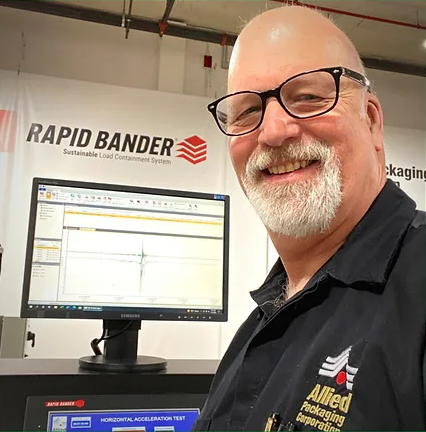Ask Steve
September 22, 2023
Question from Abby: How does stretch wrap machine condition affect load containment?
Hi Abby, that is a great question! I can confirm that machine condition will affect load containment, and in addition, it will affect your film usage. Now, let’s explore why machine condition is tied to load containment and film usage.
We stretch wrap products to prevent load failures during transportation. To be effective, the stretch film must unitize the load (pull all the components of the load together, minimizing movement), and it must resist further stretch when transportation forces are applied. To contain the load, the stretch wrap, the machine, and the process must all be optimized, and remain in that condition. If any one of those changes, so will the load containment and film usage. Picture a symphony orchestra. It is made up of various instruments, each with a unique sound, played by musicians, who follow the conductor. If the instruments are not in tune, if the musicians don’t play the correct notes, if the conductor doesn’t keep the musicians synchronized, then what we hear is nothing more than an unpleasant noise. However, if each element: instruments, musicians, and conductor are in harmony, the result is beautiful music. It is the difference between a standing ovation and the audience walking out before the concert is over.
Oddly enough, we can apply that same concept to stretch wrapping pallets: there must be a load containment standard in place, the film must be appropriate for your load containment standard, the machine must be capable of wrapping consistently to that standard. In previous Ask Steve’s I have discussed at length films (conventional vs Rapid Bander), containment standards, what causes load failures, but I have not discussed the critical role the stretch wrap machine plays.
The machine stretches the film by a certain percentage before it is applied to the load using two pre-stretch rollers. These rollers turn at different speeds, stretching the film equal to the roller’s speed differential. The film is again stretched between the machine’s carriage and the load through the tension created by the speed differential between the carriage outfeed roller and the table or arm speed. The sum of the two is what we refer to as Total Applied Stretch. Any change in Total Applied stretch will reduce load containment and increase film usage. The carriage travels vertically as the load is being wrapped creating a wrap pattern, another component of the load containment standard. As you can imagine, there are parts rotating, traveling up and down, tensions, and stretching in the machine and with all that movement, as you can imagine, there is wear. Even properly lubricated components such as bearings, sprockets, drive pulleys, belts, and chains are subject to friction, resulting in wear (which limits their lifespan). The more the machine is used, the sooner those parts need to be replaced. As an example, pre-stretch rollers typically have some surface treatment that helps them grip the film more effectively. As that surface wears, it becomes smoother, allowing the film to slip, reducing the percentage of pre-stretch, and as a result, reducing load containment and increasing film usage.
In many cases, the stretch wrap machine is overlooked when identifying critical equipment in the operation. Focus is placed on upstream machines, but a stretch wrap machine failure, in most plants, will stop production just as fast as the upstream machines. Most organizations have very competent maintenance teams, I know yours certainly does. But when it comes to the preventative maintenance needed to ensure optimum performance (by that I mean ensuring loads don’t fail during transportation, and that you don’t increase your film usage), the stretch wrap machine normally takes a backseat to the equipment upstream.
Because the stretch wrap machine is such an integral part of load containment, and we are in the business of load containment, we have developed a nationwide footprint of highly qualified Field Service Engineers to support our customers. These are experienced professionals directly employed by us to ensure our customers’ equipment is operating optimally and reliably. Our service organization is not a profit center, which enables them to concentrate on what you need without the distraction of generating revenue. Even though you have an experienced maintenance staff, we work with stretch wrap equipment all day, every day. Having professionals like ours, with that specific machine knowledge, maintain your stretch wrap equipment will allow your staff to concentrate on all those critical machines upstream. In addition to the maintenance, we perform audits at regular intervals, so any adverse change is identified and corrected on the spot.
If the equipment is old or in poor condition, we can bring it up to standard, then make sure it stays that way by maintaining it.
Thanks for asking!








